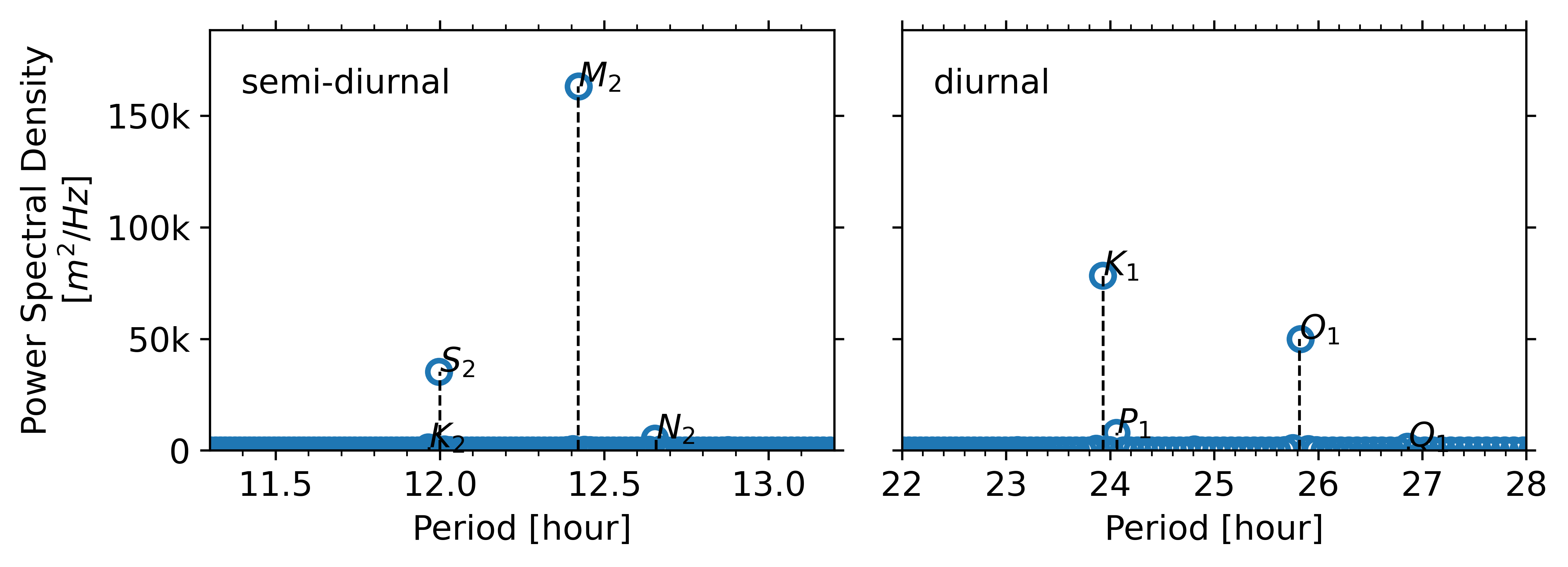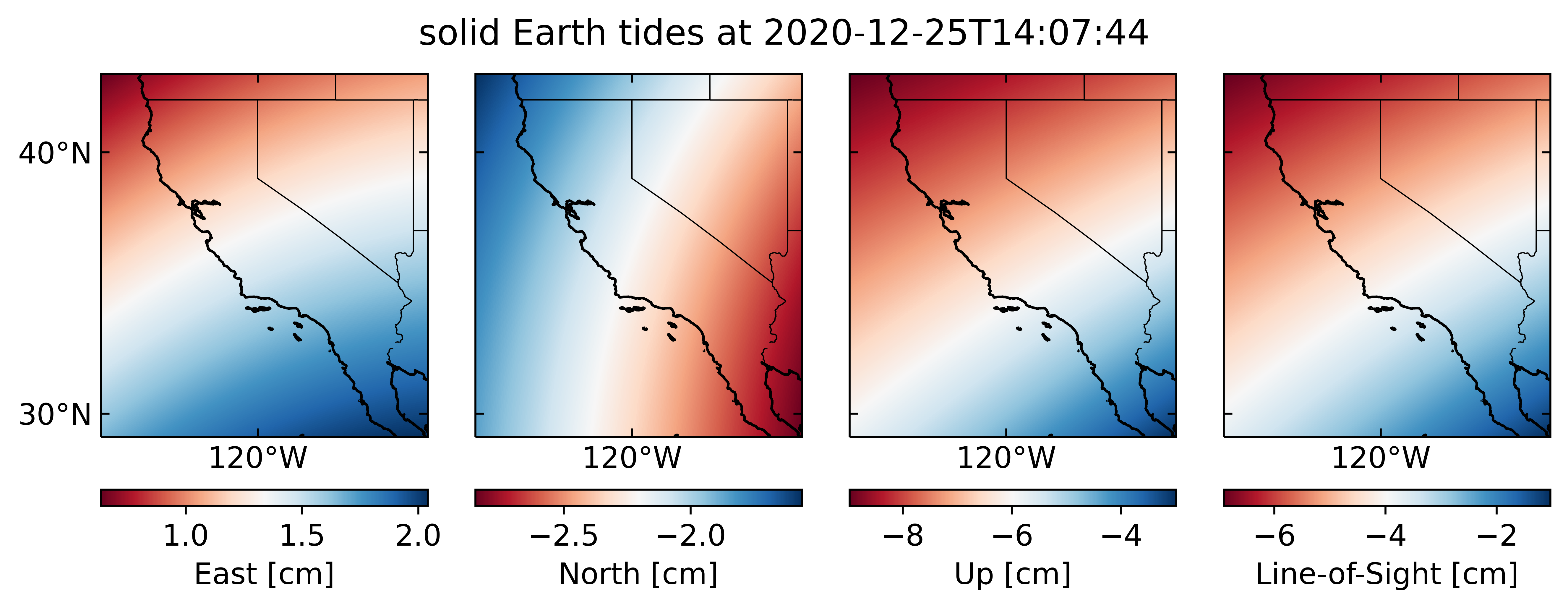A Python wrapper for solid to compute solid Earth tides
Project description
PySolid
The Python based solid Earth tides (PySolid) is a thin Python wrapper of the solid.for program (by Dennis Milbert based on dehanttideinelMJD.f from V. Dehant, S. Mathews, J. Gipson and C. Bruyninx) to calculate solid Earth tides in east/north/up direction (section 7.1.1 in the 2010 IERS Conventions). Solid Earth tides introduces very long spatial wavelength components in SAR/InSAR observations, as shown in the Sentinel-1 data with regular acquisitions and large swaths (Yunjun et al., 2022).
This is research code provided to you "as is" with NO WARRANTIES OF CORRECTNESS. Use at your own risk.
1. Install
PySolid is available on the conda-forge channel and the main archive of the Debian GNU/Linux OS. The released version can be install via conda as:
# run "conda update pysolid" to update the installed version
conda install -c conda-forge pysolid
or via apt (or other package managers) for Debian-derivative OS users, including Ubuntu, as:
apt install python3-pysolid
Installing via conda and apt is recomended because PySolid contains Fortran source code, which required compilcation. Otherwise, you may build it from source as described below.
1.1 Build from source
PySolid relies on a few Python modules as described in requirements.txt and NumPy's f2py to build the Fortran source code. You could use conda to install all the dependencies, including the Fortran compiler, or use your own installed Fortran compiler and pip to install the rest.
a. Download source code
# run "cd PySolid; git pull" to update to the latest development version
git clone https://github.com/insarlab/PySolid.git
b. Install dependencies
# option 1: use conda to install dependencies into an existing, activated environment
conda install -c conda-forge fortran-compiler --file PySolid/requirements.txt
# option 2: use conda to create a new environment named "pysolid"
conda env create -f PySolid/environment.yml
conda activate pysolid
# option 3: have a Fortran compiler already installed and use pip to install the rest dependencies
python -m pip install -r PySolid/requirements.txt
c. Install PySolid
# option 1: use pip to install pysolid into the current environment
# use "pip install -e" to install in the development mode
python -m pip install PySolid
# option 2: manually compile the Fortran code and setup environment variable
cd PySolid/src/pysolid
f2py -c -m solid solid.for
export PYTHONPATH=${PYTHONPATH}:~/tools/PySolid
1.2 Test the installation
To test the installation, run the following:
python -c "import pysolid; print(pysolid.__version__)"
python PySolid/tests/grid.py
python PySolid/tests/point.py
2. Usage
PySolid could compute solid Earth tides in two modes: point and grid. Both modes produce displacement in east, north and up direction.
- Point mode: compute 1D tides time-series at a specific point for a given time period
- Grid mode: compute 2D tides grid at a specific time for a given spatial grid
2.1 Point Mode [notebook]
import datetime as dt
import pysolid
# prepare inputs
lat, lon = 34.0, -118.0 # point of interest in degree, Los Angles, CA
step_sec = 60 * 5 # sample spacing in time domain in seconds
dt0 = dt.datetime(2020, 1, 1, 4, 0, 0) # start date and time
dt1 = dt.datetime(2021, 1, 1, 2, 0, 0) # end date and time
# compute SET via pysolid
dt_out, tide_e, tide_n, tide_u = pysolid.calc_solid_earth_tides_point(
lat, lon, dt0, dt1,
step_sec=step_sec,
display=False,
verbose=False,
)
# plot the power spectral density of SET up component
pysolid.plot_power_spectral_density4tides(tide_u, sample_spacing=step_sec)


2.2 Grid Mode [notebook]
import datetime as dt
import numpy as np
import pysolid
# prepare inputs
dt_obj = dt.datetime(2020, 12, 25, 14, 7, 44)
meta = {
'LENGTH' : 500, # number of rows
'WIDTH' : 450, # number of columns
'X_FIRST': -126, # min longitude in degree (upper left corner of the upper left pixel)
'Y_FIRST': 43, # max laitude in degree (upper left corner of the upper left pixel)
'X_STEP' : 0.000925926 * 30, # output resolution in degree
'Y_STEP' : -0.000925926 * 30, # output resolution in degree
}
# compute SET via pysolid
tide_e, tide_n, tide_u = pysolid.calc_solid_earth_tides_grid(
dt_obj, meta,
display=False,
verbose=True,
)
# project SET from ENU to radar line-of-sight (LOS) direction with positive for motion towards satellite
# inc_angle : incidence angle of the LOS vector (from ground to radar platform) measured from vertical.
# az_angle : azimuth angle of the LOS vector (from ground to radar platform) measured from the north, with anti-clockwirse as positive.
inc_angle = np.deg2rad(34) # radian, typical value for Sentinel-1
az_angle = np.deg2rad(-102) # radian, typical value for Sentinel-1 descending track
tide_los = ( tide_e * np.sin(inc_angle) * np.sin(az_angle) * -1
+ tide_n * np.sin(inc_angle) * np.cos(az_angle)
+ tide_u * np.cos(inc_angle))

3. Citing this work
- Yunjun, Z., Fattahi, H., Pi, X., Rosen, P., Simons, M., Agram, P., & Aoki, Y. (2022). Range Geolocation Accuracy of C-/L-band SAR and its Implications for Operational Stack Coregistration. IEEE Trans. Geosci. Remote Sens., 60, 1-19, doi:10.1109/TGRS.2022.3168509, arXiv, data, notebooks.
- Milbert, D. (2018), "solid: Solid Earth Tide", [Online]. Available: http://geodesyworld.github.io/SOFTS/solid.htm. Accessd on: 2020-09-06.
Project details
Release history Release notifications | RSS feed
Download files
Download the file for your platform. If you're not sure which to choose, learn more about installing packages.

















